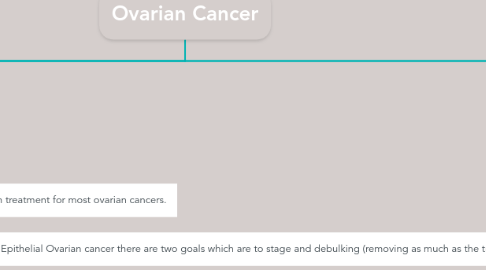
1. Diagnostics
1.1. A blood test can be ran that will show an increase in CA-125 when a cancerous tumor is present.
1.2. Granulosa cell tumors are detected with the blood indicators Inhibin B and A.
1.3. Trans-vaginal ultrasound can detect a tumor.
1.4. Human Chorionic gonadotropin serum fetoprotein. An elevation indicates tumor progression.
1.5. Exploratory laparotomy to visualize time and help diagnose and to stage the tumor.
1.6. Pelvic exam
1.7. CT scan to help define the tumor's boundaries if tumor is present.
1.8. Biopsy to confirm presence of tumor.
2. Signs and Symptoms
2.1. Signs and symptoms vary due to the size of the tumor.
2.2. Common symptoms.
2.2.1. Back pain
2.2.2. Fatigue
2.2.3. Bloating
2.2.4. Constipation
2.2.5. Abdominal pain
2.2.6. Urinary urgency
2.2.7. Abdominal distention
2.2.8. Vaginal bleeding
2.2.9. Weight loss
2.2.10. Pelvic pain
2.3. Early Signs
2.3.1. Bloating
2.3.2. Changes in bowel patterns
2.3.3. May appear thin, ill, or wasted away
2.4. Risk factors
2.4.1. The exact cause is unknown, but many factors seem to play a role in the development of ovarian cancer.
2.4.1.1. A family history of ovarian cancer
2.4.1.2. A diet high in saturated fats
2.4.1.3. Women who have more menstrual cycles, late menopause, early menopause, or infertility
2.4.1.4. Exposures to talc or to asbestos
2.4.1.5. BRAC 1 or BRAC 2 gene mutations can increase the risk
2.4.1.6. May be associated with Lynch's syndrome
3. Treatments
3.1. Surgery
3.1.1. Is the main treatment for most ovarian cancers.
3.1.1.1. For Epithelial Ovarian cancer there are two goals which are to stage and debulking (removing as much as the tumor as possible)
3.1.2. Ovarian germ cell tumors are treated with a hysterectomy and bilateral salpingo-oophorectomy. Only the ovary containing the cancer and the Fallopian tube on the same side are removed.
3.2. Chemotherapy
3.2.1. Given in a way that lets them enter the bloodstream
3.2.2. Systemic chemotherapy is given to a patient who's cancer has metastasized. Mostly gave IV, by mouth, or by Cather directly into the abdominal cavity.
3.2.3. The standard approach is the combination of drugs.
3.2.3.1. Cisplatin or carboplatin and a taxable such as paclitaxel Taxol or docetaxel.
3.3. Many doctors favor Carboplatin over Cisplatin due to fewer side affects.
3.4. Hormone Therapy
3.4.1. LHRH. Switches off estrogen production by the ovaries
3.4.2. Tamoxifen. Used to treat advanced epithelial ovarian cancer.
3.4.3. Aromatase Inhibitors that block the enzyme aromatase that block it that turns other hormones into estrogen in post-menopausal women.
3.5. Radiation Therapy
3.5.1. The main type of radiation therapy that is used is external beam radiation. This is similar to getting an x-ray.
3.6. Targeted Therapy
3.6.1. Is a newer treatment method that uses drugs to identity and attack cancer cells while doing little damage to the normal cells.
3.6.1.1. Types of targeted therapies
3.6.1.1.1. PARP inhibitors. These help repair damages DNA inside the cells of the ovary.
3.6.1.1.2. Olaparib and rucaparib treat advanced ovarian cancers after chemotherapy has been tried. This type of treatment is used mainly on women who have the BRCA gene mutation.
3.6.1.1.3. Niraparib is used to treat recurrent ovarian cancers.
3.6.1.1.4. Bevacizumab has been shown to shrink or slow the growth of epithelial ovarian cancers.
4. Incidence/prevalence
4.1. Highest occurrence is in postmenopausal women
4.2. 50% of cases occur in women over the age of 63
4.3. Very rare, but it can occur in childhood or during pregnancy
4.4. Occurs in 1 in 70 women
4.5. Women with European ancestry have higher rates
4.6. Asian women have higher rates
4.7. 7 per 100,000 females per year are diagnosed
4.8. In developing countries the incidence is 5 times higher than women in developed countries.
5. Pathogenesis
5.1. Ovarian cancer begins in the ovaries. The ovaries are the reproductive glands found in only females
5.2. Malignant ovarian tumors can metastasize to other parts of the body and become fatal.
5.3. Ovarian cancer occurs when a cell's growth is mutated and the cells starts to grow abnormally at a very fast rate. This causes a tumor that could possibly spread to other parts of the body.
5.3.1. The ovaries are made up of three types of cells that can produce cancer.
5.3.1.1. Stromal tumors start from the stromal tissues cells that hold the ovary together and produce the hormones progesterone and estrogen.
5.3.1.2. Germ cells that starts from cells that produce the egg (ova). This is a rare form of ovarian cancer and is found mostly in younger women.
5.3.1.3. Epithelial cells that cover the outer surface of the ovary. This type makes up for about 90% of ovarian cancers.
5.4. Epithelial ovarian cancer is composed of a diverse group of tumors.
5.4.1. Type I which is low-grade serous, low grade endometriosis clear cell carcinoma.
5.4.2. Type II are highly aggressive and evolve rapidly and almost always present in the advanced stage.
